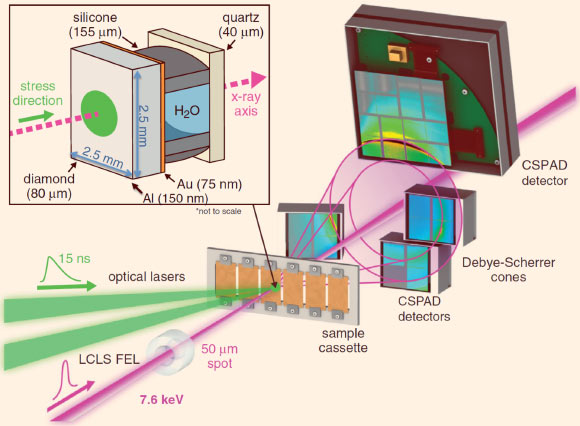A Stanford-led research team has captured the freezing of water, molecule-by-molecule, into a super-dense, exotic form of ice called ice VII. The results are published in the journal Physical Review Letters.

Experimental configuration of the X-ray Free Electron Laser probe and optical laser; the shock freezing behavior of water captured in a Debye-Scherrer geometry. Inset: schematic of target package as a cut away side view. Image credit: Gleason et al, doi: 10.1103/PhysRevLett.119.025701.
Ice VII (ice seven) is a cubic crystalline form of ice that was discovered in 1937 by the American physicist and Nobel Prize winner Percy Williams Bridgman.
It can be formed from liquid water above 3 GPa (30,000 atmospheres) by lowering its temperature to ambient temperatures, or by decompressing D2O ice VI below 95 Kelvin.
Some scientists hypothesize that ice VII may even be present on watery exoplanets and several icy moons of the Solar System’s outer planets.
“Any icy satellite or planetary interior is intimately connected to the object’s surface,” said lead author Dr. Arianna Gleason, a scientist in the Extreme Environments Laboratory of Stanford’s School of Earth, Energy & Environmental Sciences and a postdoctoral fellow at Los Alamos National Laboratory.
“Learning about these icy interiors will help us understand how the worlds in our Solar System formed and how at least one of them, so far as we know, came to have all the necessary characteristics for life.”
“There have been a tremendous number of studies on ice VII because everyone wants to understand its behavior,” added senior author Dr. Wendy Mao, a Stanford Institute for Materials and Energy Sciences (SIMES) principal investigator.
“What our new study demonstrates, and which hasn’t been done before, is the ability to see the ice structure form in real time.”
Physical chemists have long studied how materials undergo phase changes between gas, liquid and solid states. Phase changes can happen rapidly, however, and on the tiny scale of mere atoms.
Previous research has struggled to capture the moment-to-moment action of phase transitions, and instead worked backward from stable solids in piecing together the molecular steps taken by predecessor liquids.
In their experiments, Dr. Mao, Dr. Gleason and co-authors used the Linac Coherent Light Source, the world’s most powerful X-ray laser located at the SLAC National Accelerator Laboratory.
The team beamed an intense, green-colored laser at a small target containing a sample of liquid water.
The laser instantly vaporized layers of diamond on one side of the target, generating a rocket-like force that compressed the water to pressures exceeding 5 GPa (50,000 atmospheres).
As the water compacted, a separate beam from an instrument called the X-ray Free Electron Laser arrived in a series of bright pulses only a femtosecond, or a quadrillionth of a second, long.
Akin to camera flashes, this strobing X-ray laser snapped a set of images revealing the progression of molecular changes, flip book-style, while the pressurized water crystallized into ice VII.
The phase change took just 6 billionths of a second, or nanoseconds.
Surprisingly, during this process, the water molecules bonded into rod shapes, and not spheres as theory predicted.
“Our experiments with water are the first of their kind, allowing us to witness a fundamental disorder-to-order transition in one of the most abundant molecules in the Universe,” Dr. Gleason said.
_____
A.E. Gleason et al. 2017. Compression Freezing Kinetics of Water to Ice VII. Phys. Rev. Lett 119 (2): 025701; doi: 10.1103/PhysRevLett.119.025701







